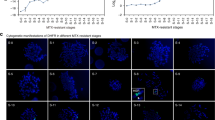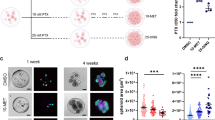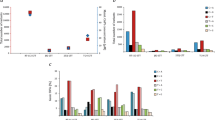Abstract
Following EMS mutagenesis, three estramustine (EM) resistant DU 145 human prostatic carcinoma cell lines were clonally selected by exposure to incrementally increasing concentrations of the drug. Although only low levels of resistance (approximately 3-fold) were attainable, this resistance was stable in the absence of continuous drug exposure. These EM-resistant clones (EMR 4,9,12) did not exhibit cross resistance to vinblastine, taxol, or adriamycin, and had collateral sensitivity to cytochalasin B. None of the lines had elevated expression of P-glycoprotein mRNA or glutathione S-transferase activity, suggesting a phenotype distinct from the classic multi-drug resistance phenotype. This conclusion was supported further by the observation that two MDR cell lines (FLC mouse erythroleukaemic and SKOV3 human ovarian carcinoma cells) showed sensitivity to EM. Fluorescent activated cell sorting analysis of the effects of EM on cell cycle traverse revealed that at EM concentrations up to 20 microM an increasing percentage of wild type cells were blocked in G2/M; no such effect occurred in EMR lines. Differential interference contrast microscopy was employed to study EM's effect on mitosis. EMR lines were able to form functional, albeit smaller, spindles at EM concentrations that resulted in chromosomal disorganisation and inhibition of mitotic progression in wild type cells. EMR lines were able to progress through mitosis and cytokinesis at the same rate as untreated cells. Tritiated EM was used to evaluate potential drug uptake/efflux mutations in ERM clones. EMR 4 and 9 incorporate less EM than wild type cells; however, they have significantly decreased cellular volumes. The initial efflux rate constants for EMR clones were greater than for wild type cells. Within 5 min greater than 70% of the drug was lost from resistant cells compared to a 50% loss by the wild type. Although the specific mechanisms of resistance have yet to be defined, the lack of collateral resistance to other MDR/anti-microtubule agents could serve as the basis for the clinical use of EM in combination chemotherapy.
This is a preview of subscription content, access via your institution
Access options
Subscribe to this journal
Receive 24 print issues and online access
$259.00 per year
only $10.79 per issue
Buy this article
- Purchase on Springer Link
- Instant access to full article PDF
Prices may be subject to local taxes which are calculated during checkout
Similar content being viewed by others
Author information
Authors and Affiliations
Rights and permissions
About this article
Cite this article
Speicher, L., Sheridan, V., Godwin, A. et al. Resistance to the antimitotic drug estramustine is distinct from the multidrug resistant phenotype. Br J Cancer 64, 267–273 (1991). https://doi.org/10.1038/bjc.1991.290
Issue Date:
DOI: https://doi.org/10.1038/bjc.1991.290



